Download Pdf [2,03 MB] - MTU Aero Engines
Download Pdf [2,03 MB] - MTU Aero Engines
Download Pdf [2,03 MB] - MTU Aero Engines
You also want an ePaper? Increase the reach of your titles
YUMPU automatically turns print PDFs into web optimized ePapers that Google loves.
Pilotless aircraft<br />
By Andreas Spaeth<br />
The joke is as old as the autopilot: Sitting alone in the cockpit of a modern aircraft are a pilot and a<br />
dog. The pilot is there to feed the dog, and the dog is there to bite the pilot as soon as he tries to<br />
touch anything. Scenarios like that aren’t the last word in aircraft automation, however. Experts are<br />
confident that air traffic is moving relentlessly toward full automation and abolition of the cockpit. You<br />
may wonder whether passengers will go along with that.<br />
“The question is not whether pilotless aircraft<br />
are coming, but when. We’ll have to<br />
face it,” says Denis Chagnon, a spokesperson<br />
with the International Civil Aviation Organization<br />
(ICAO) in Montréal. In Europe and the<br />
United States, research activities are bustling:<br />
The airliner-to-be finds its way across<br />
the sky more or less on its own, with no pilot<br />
onboard, and is monitored and controlled, if<br />
necessary, from the ground. Such capability<br />
is expected to make flying more efficient, environmentally<br />
friendlier and safer.<br />
Unmanned aerial vehicles (UAVs) flying military<br />
missions are not new, being used as<br />
robots to patrol outside of controlled airspace.<br />
In the civil arena, UAVs are in a first<br />
step supposed to assist civil science in tasks<br />
such as environmental monitoring, volcano<br />
observation and atmospheric research. For<br />
such tasks, pilotless aircraft benefit from their<br />
ability to stay aloft longer than their manned<br />
counterparts.<br />
In Europe, researchers are examining the<br />
utility of civil UAVs within a new air traffic<br />
control system: The European Defense<br />
Agency (EDA) is presently pursuing a roadmap<br />
study to assess the compatibility of civil<br />
UAV missions with concurrent manned aircraft<br />
operations in the crammed European<br />
airspace. A consortium of 12 leading European<br />
aerospace companies is trying to find<br />
ways to implement such coexistence no later<br />
than by year-end 2015.<br />
Simultaneously, the European Commission is<br />
pursuing a research project that is dubbed<br />
Innovative Future Air Transport System<br />
(IFATS) and coordinated by the French Onera<br />
research organization. Sharing in it also is<br />
the German <strong>Aero</strong>space Center (DLR). The<br />
IFATS concept envisions the formation of a<br />
new global airspace management system<br />
that computes four-dimensional flight routes<br />
for all air traffic participants. “That’s a revolutionary<br />
system considering there’re no<br />
pilots in the aircraft and no controllers, both<br />
being replaced by control systems on the<br />
ground,” explains Onera’s Claude Le Tallec. A<br />
substantial benefit it affords is improved utilization<br />
of the airspace through automated<br />
control of the aircraft in all flight phases from<br />
taxiing out from the airport of departure to<br />
parking the aircraft at the destination airport.<br />
The IFATS team is also looking into the estimated<br />
costs of a pilotless airliner: Development<br />
investments would run around 525<br />
million euros and purchase of a 230-passenger<br />
airliner almost 38 million euros. Omission<br />
of the cockpit would provide room for<br />
ten additional passengers. In terms of efficiency<br />
improvement, each aircraft could fly<br />
80 hours longer per year than a conventional<br />
jet transport and use up to 3,000 liters less<br />
fuel per hour.<br />
As yet, there’re many unknowns in these revolutionary<br />
simulations: precautions must be<br />
in place, for instance, to keep control of the<br />
aircraft from being criminally manipulated<br />
from the ground. The most critical question,<br />
however, involves the passengers. Will these<br />
people trust an automated system? While the<br />
Driverless train: Germany’s first fully automated<br />
subway has been in operation in Nuremberg since<br />
2008.<br />
use of driverless subway trains has become<br />
commonplace in many cities, many passengers<br />
of high-speed intercity trains may begin<br />
to hesitate knowing there is no driver up<br />
front. A German poll indicated that with a<br />
pilotless aircraft, 33 percent of the passengers<br />
will not come aboard in the first place,<br />
and 48 percent only provided a pilot is onboard<br />
to monitor the computers. Only 19 percent<br />
of the respondents said they wouldn’t<br />
mind traveling without a pilot.<br />
Nonetheless, there’re facts speaking for the<br />
pilotless aircraft: Demonstrably, many flight<br />
catastrophes are attributable to human<br />
error, and the Onera experts and others are<br />
confident that human error is exactly what<br />
can practically be eliminated by automated<br />
aircraft.<br />
For additional information, contact<br />
Heidrun Moll<br />
+49 89 1489-3537<br />
For further information on this article go to:<br />
www.mtu.de/108UAV_E<br />
30 Interview + Report<br />
31


![Download Pdf [2,03 MB] - MTU Aero Engines](https://img.yumpu.com/11154858/16/500x640/download-pdf-203-mb-mtu-aero-engines.jpg)
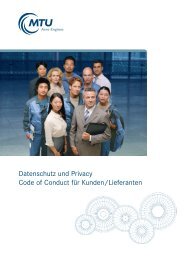

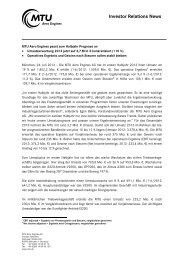
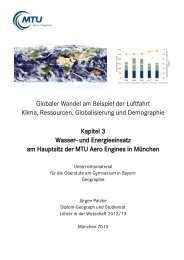
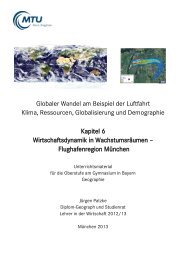
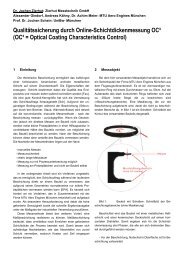
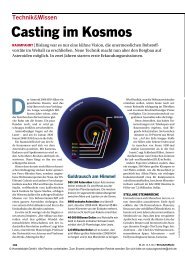

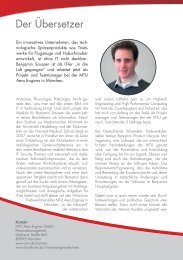
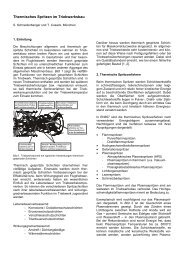
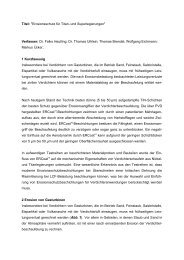



![Download PDF [5,37 MB] - MTU Aero Engines](https://img.yumpu.com/21945461/1/190x125/download-pdf-537-mb-mtu-aero-engines.jpg?quality=85)